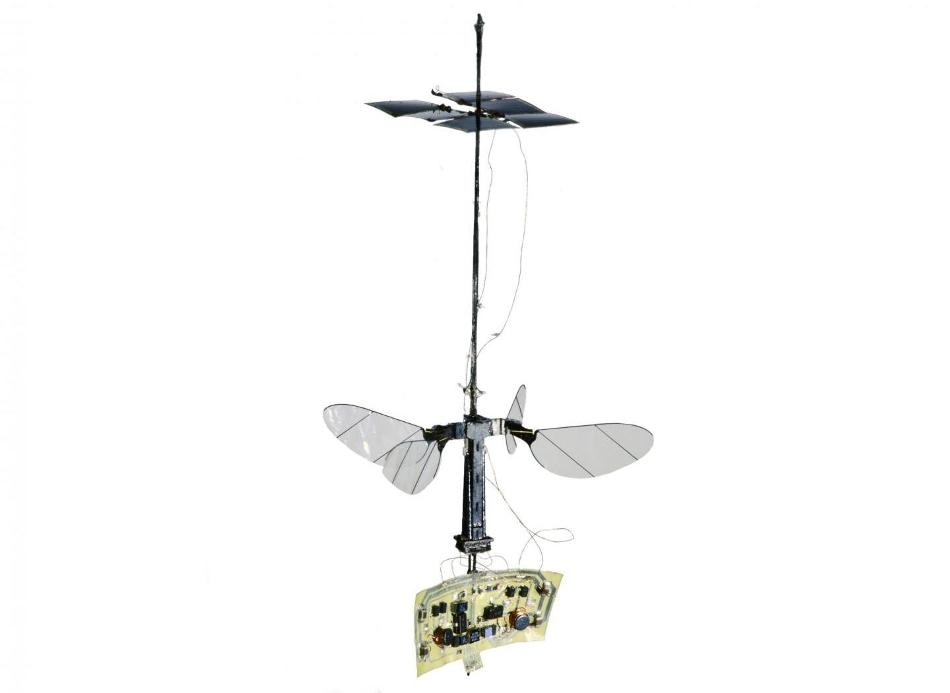Jun 27 2019
On a late afternoon in August, several years of research in the Harvard Microrobotics Lab, climaxed in a moment of stress as the tiny, revolutionary RoboBee began its first solo flight.
 Changes to the Robobee — including an additional pair of wings and improvements to the actuators and transmission ratio — made the vehicle more efficient and allowed the addition of solar cells and an electronics panel. This Robobee is the first to fly without a power cord and is the lightest, untethered vehicle to achieve sustained flight. (Image credit: Harvard Microrobotics Lab/Harvard SEAS)
Changes to the Robobee — including an additional pair of wings and improvements to the actuators and transmission ratio — made the vehicle more efficient and allowed the addition of solar cells and an electronics panel. This Robobee is the first to fly without a power cord and is the lightest, untethered vehicle to achieve sustained flight. (Image credit: Harvard Microrobotics Lab/Harvard SEAS)
Graduate student Elizabeth Farrell Helbling, PhD ’19, and postdoctoral fellow Noah T. Jafferis from the Harvard John A. Paulson School of Engineering and Applied Sciences (SEAS), the Graduate School of Arts and Sciences and The Wyss Institute for Biologically Inspired Engineering captured the moment on camera.
Helbling, who has been involved in the project for six years, counted down.
“Three, two, one, go.”
The bright halogens turned on and the solar-driven RoboBee propelled into the air. For a frightening second, the minute robot, still without on-board control and steering, sped towards the lights.
Off camera, Helbling called out and the power was cut. The RoboBee dropped dead out of the air, caught by its Kevlar safety harness.
“That went really close to me,” Helbling said, with a tense laugh.
“It went up,” Jafferis, who has also worked on the project for around six years, responded enthusiastically from the high-speed camera monitor where he was recording the test.
To sum up, Harvard University’s RoboBee realized its latest significant breakthrough — becoming the lightest vehicle ever to accomplish sustained untethered flight.
“This is a result several decades in the making,” said Robert Wood, Charles River Professor of Engineering and Applied Sciences at SEAS, Core Faculty member of the Wyss Institute and chief investigator of the RoboBee project. “Powering flight is something of a Catch-22 as the tradeoff between mass and power becomes extremely problematic at small scales where flight is inherently inefficient. It doesn’t help that even the smallest commercially available batteries weigh much more than the robot. We have developed strategies to address this challenge by increasing vehicle efficiency, creating extremely lightweight power circuits, and integrating high-efficiency solar cells.”
The breakthrough is illustrated in Nature.
To accomplish untethered flight, this newest iteration of the Robobee endured numerous imperative alterations, including the incorporation of a second pair of wings.
"The change from two to four wings, along with less visible changes to the actuator and transmission ratio, made the vehicle more efficient, gave it more lift, and allowed us to put everything we need on-board without using more power," said Jafferis.
(The incorporation of the wings also got this Robobee the label X-Wing, after the four-winged starfighters from Star Wars.)
That additional lift, with no extra power necessities, allowed the scientists to cut the power cord — which has kept the Robobee hitched for virtually a decade — and integrate solar cells and an electronics panel to the vehicle.
The tiniest commercially available solar cells weigh 10 mg each with 0.76 mW per mg of power when the sun is at full intensity. The Robobee X-Wing requires the power of about three Earth suns to fly, and hence outdoor flight is not on the cards as of now. Instead, the scientists mimic that level of sunlight with halogen lights in the lab.
The solar cells are linked to an electronics panel under the bee, which changes the low voltage signals of the solar array into high voltage drive signals necessary to regulate the actuators. The solar cells are placed about 3cm above the wings, to prevent interference.
Altogether, the final vehicle including the solar cells and electronics, weighs 259 mg (roughly a quarter of a paper clip) and consumes about 120 mW of power, which is less power than what is consumed by a single bulb on a string of LED Christmas lights.
"When you see engineering in movies, if something doesn't work, people hack at it once or twice and suddenly it works. Real science isn't like that," said Helbling. "We hacked at this problem in every which way to finally achieve what we did. In the end, it's pretty thrilling."
Going forward, the team will continue working on the Robobee to decrease the power and incorporate on-board control to enable it to fly outside.
Over the life of this project, we have sequentially developed solutions to challenging problems, like how to build complex devices at millimeter scales, how to create high-performance millimeter-scale artificial muscles, bio-inspired designs, and novel sensors, and flight control strategies. Now that power solutions are emerging, the next step is onboard control. Beyond these robots, we are excited that these underlying technologies are finding applications in other areas such as minimally-invasive surgical devices, wearable sensors, assistive robots, and haptic communication devices — to name just a few.
Robert Wood, Chief Investigator and Charles River Professor of Engineering and Applied Sciences, Harvard University
The Untethered RoboBee
Changes to the Robobee — including an additional pair of wings and improvements to the actuators and transmission ratio — made the vehicle more efficient and allowed the addition of solar cells and an electronics panel. This Robobee is the first to fly without a power cord and is the lightest, untethered vehicle to achieve sustained flight. (Credit - Harvard Microrobotics Lab/Harvard SEAS)